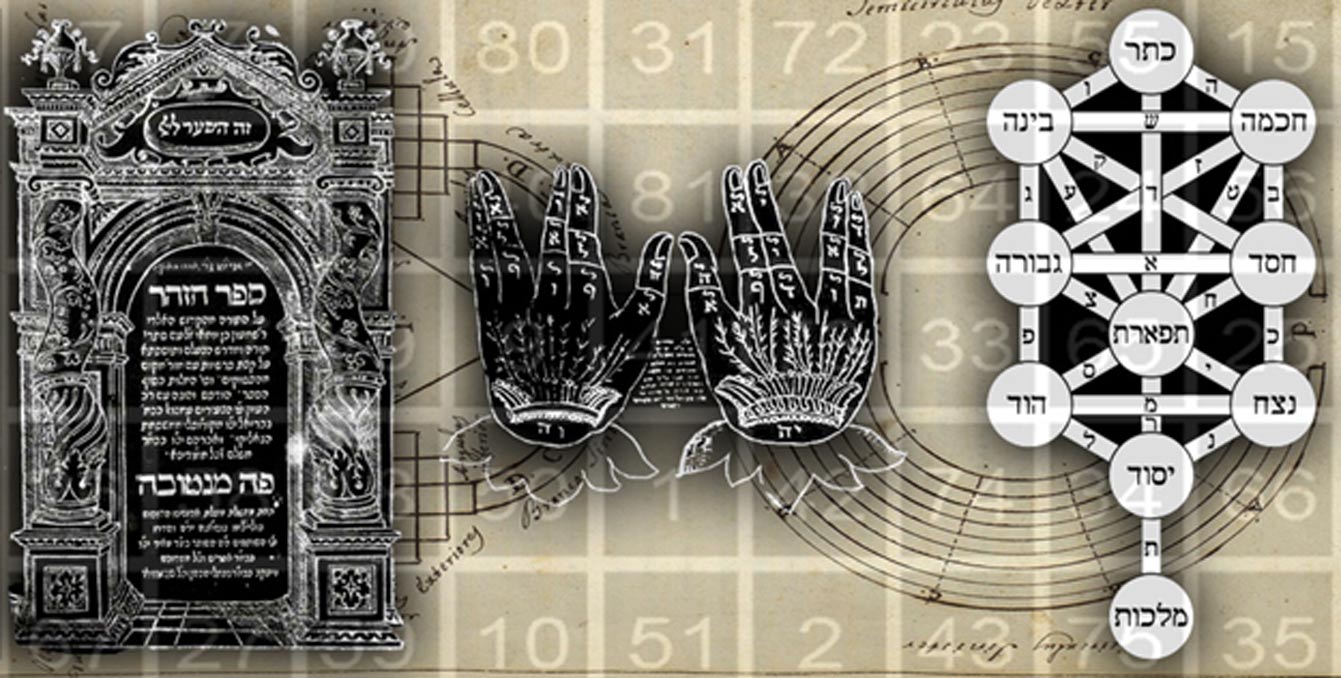
Gematria: Esoteric Numerology Based on the Hebrew Kabbalah
Having long been fascinated with the mysterious power of numbers, enough to write two books on the topic, we often sidestepped the subject of numerology because of its lack of a true scientific basis. Yet ancient and esoteric traditions looked at numerology as not only a tool for divination, but a method of acquiring knowledge beyond that of the five senses, even as a path to know the divine itself.
W.E.B. DuBois once stated, “When you have mastered numbers, you will in fact no longer be reading numbers, any more than you read words when reading books. You will be reading meanings.” There are various systems of numerology that examine number associations with names, dates, and locations and then serve to interpret meaning behind them, usually in conjunction with predicting the future or in charting someone’s destiny.
Numerology evolved over time by also absorbing influences of Christian mysticism, Gnosticism, the Vedas, and eastern esotericism, yet is said to have its roots in Pythagorean mathematics. Pythagoras was an ancient Greek philosopher and mathematician (570 to 490 BCE) who became known as the grandfather of mathematics.
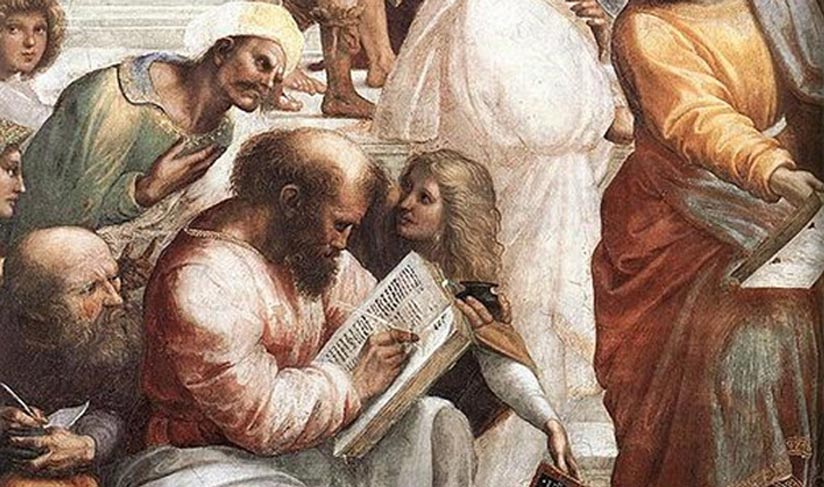
Detail of Pythagoras writing from ‘The School of Athens.’ By Raphael. (Public Domain)
Gematria, an Ancient Mystical Tradition
One of the oldest numerological traditions, and indeed one of the oldest references to numerology itself, comes from the Hebrew Kabbalah. Known as “Gematria,” this mystical tradition has its roots in Assyrian and Babylonian numerological systems, as well as later Greek influences. But it was the Hebrew culture that gave the practice of assigning numerical values to a word or a phrase its depth. Gematria is mainly associated with the Hebrew language, and sometimes Aramaic, but there exists Gematria using Arabic, Spanish and Greek languages as well.
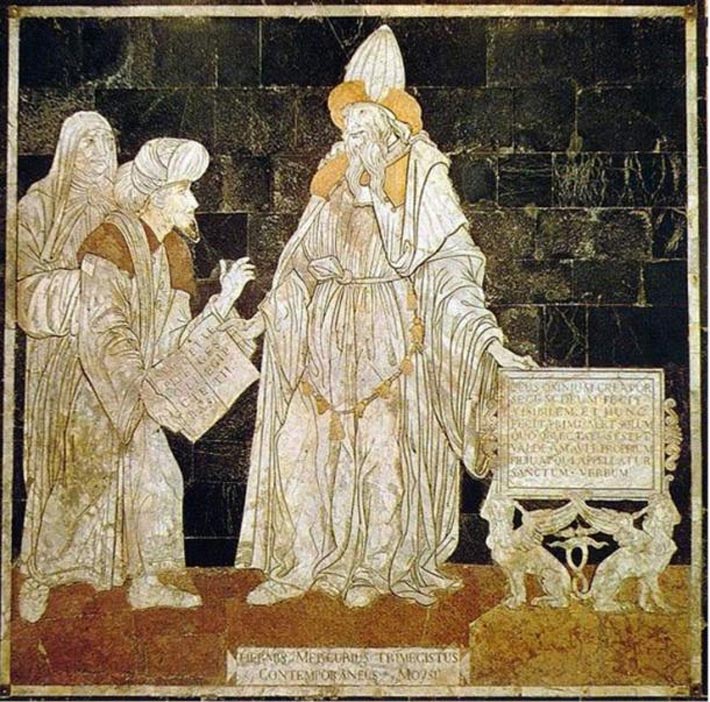
Floor inlay depicting Hermes Mercurius Trismegistus – the combination of the Greek god Hermes and the Egyptian god Thoth, gods of writing and of magic in their respective cultures. Circa 1480s. (Public Domain)
Its use dates as far back as the Tannaic, or Mishnaic, period of 10 – 220 CE, although, the use of Gematria in other, older traditions could date back to the Assyrian culture between 727-705 BC, when the ruler Sargon II was said to have built the wall of Khorsabad, the Assyrian capital, exactly 16,283 cubits in length, which corresponded to the numerical value of his name.
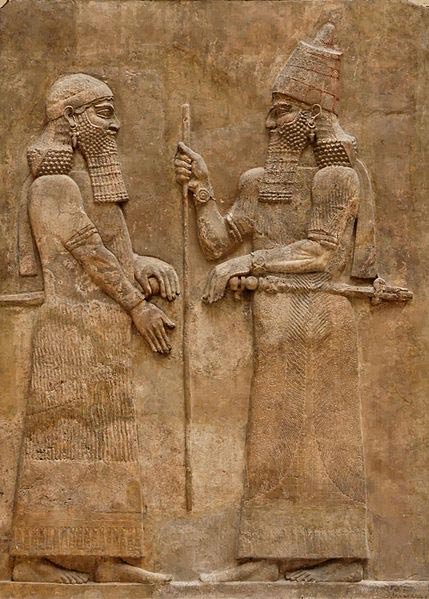
Sargon II and dignitary. Low-relief from the L wall of the palace of Sargon II at Dur Sharrukin in Assyria (now Khorsabad in Iraq), cicrca 716–713 BC. (Public Domain)
Numerology Creates Links and Pathways
Numerology in general is a system of giving relational value to numbers that align with the letters of a person’s name, birth date or even the date of a historical event. Like astrology, numerology creates links between numbers and characteristics, values and even life paths. Gematria, which derives its name from the Greek word “geometria” or geometry, seeks to find that deeper link between numerical values and alphabetical values.
There are two basic types of Gematria; the “revealed” present in rabbinic literature throughout the ages; and the “mystical,” which is a part of Kabbalah, the mystical branch of Judaism. The revealed form has roots in the Talmud and Midrash and the end result of the corresponding letters and numerical values often held prophetic insights. The mystical tradition is more widely known because of the popularity of Kabbalah even today, and focuses on the ten sefirot on the Kabbalistic tree of life, along with the 22 letters of the Hebrew alphabet.
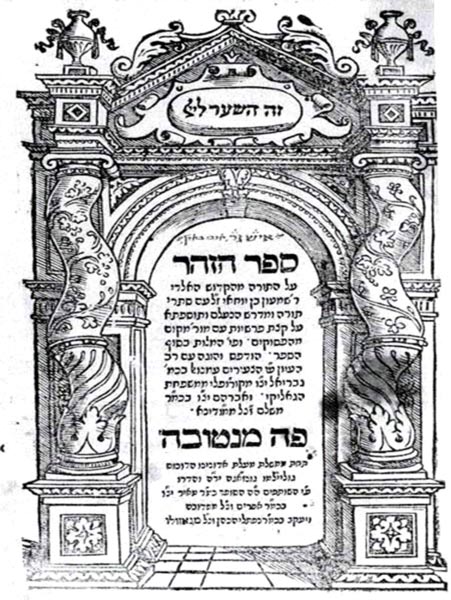
Title page of first edition of the Zohar, Mantua, 1558. (Public Domain)
Later, it evolved associations with letters of the alphabet and 22 solids formed by regular polygons, thanks to further contributions by the Zohar, a group of texts considered the foundational works in Jewish Kabbalistic literature that offer scriptural interpretations, commentary on spiritual mysticism and deeper discussions of the nature of God and the origin of the universe. The body of works that make up the Zohar indeed were instrumental in shaping Kabbalah, and included within that, Gematria.
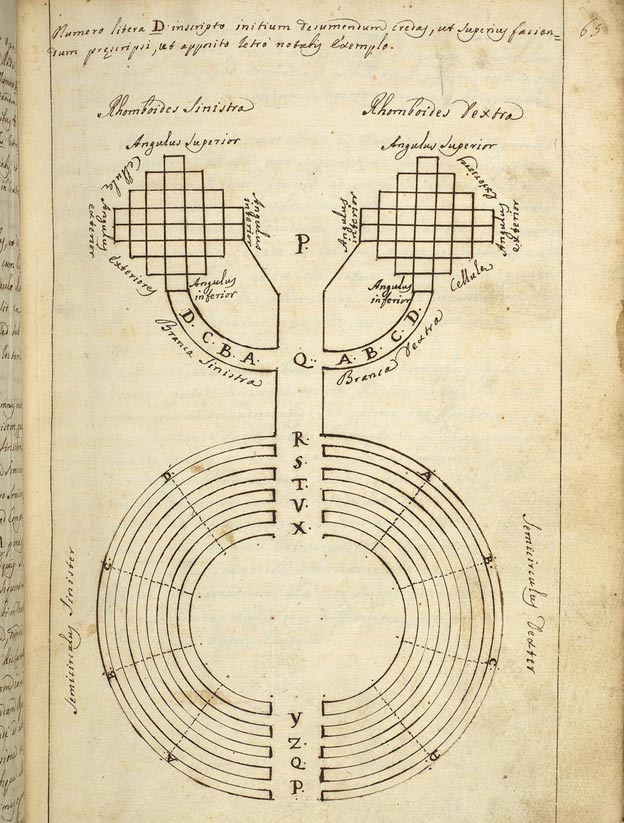
16th-century treatise on Kabbalistic Gematria (the mystical interpretation of language), in which strings of letters, in this case Latin sentences, are assigned a numerical value. (Public Domain)
The Hidden Bible Code
During the 13th century, Kabbalists believed the Old Testament of the Bible held within it a hidden code and the key to unlocking that code was the Gematria. The more modern belief in a Bible Code gained some popularity in 1994 after the publication of a paper in Statistical Science Journal by three mathematicians and scholars, called “Equidistant Letter Sequences in the Book of Genesis.” The scholars, Doron Witztum, Eliyahu Rips and Yoav Rosenberg used “ELS” to find words and phrases embedded in the text. This later led to the controversial books ‘The Bible Code” and “The Bible Code II: The Countdown” by Michael Drosnin, but the basic method used was similar to Gematria.
Scholars of Hebrew texts recognize the long held practice in early Jewish traditions of counting the number of times a particular word, phrase, number, paragraph or letter appears in scriptures. Known as Soferim, these “counters” were able to use their skill to ensure that each scroll of the Torah was identical and replicated exactly as the original. Gematria follows a similar understanding of the importance of numbers and letters in providing insight into words and concepts in the sacred text itself. In other words, Gematria looked for what was being written “between the lines” by identifying for patterns, codes and repetitions. Why do this?
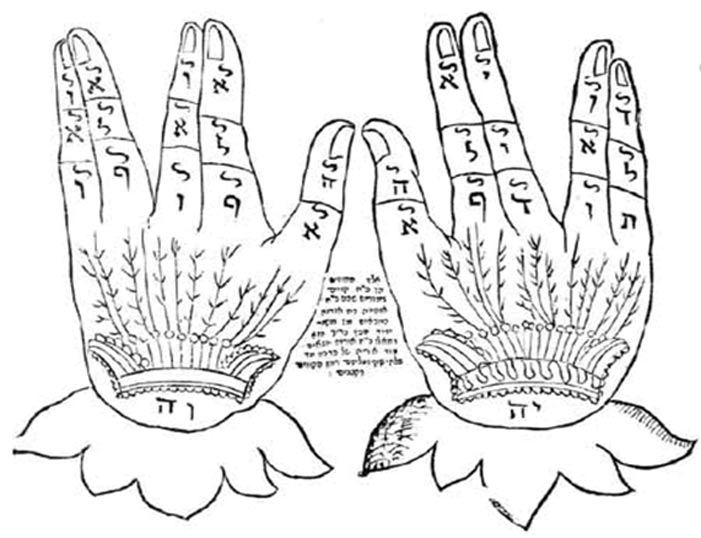
The position of each hand in this image forms the Hebrew letter shin ( ש ), the first letter in en:Shaddai ( שדי ), the name of God that refers to Him as a protector. (Public Domain)
It all goes back to the belief that the “word” was the origin of creation itself. “In the beginning was the Word,” was God speaking into existence all of life itself. The word itself is powerful, generative, and thus the letters making up the word, or words of God, as in holy texts, must be broken down to the letter. Each letter thus takes on a powerful meaning, and by giving each letter a coinciding numerical value, each number then takes on an even more profound meaning, like the layers of an onion. Thus, the words in the Torah, which were believed to be the holy speech of divine inspiration, had a hidden meaning beyond the obvious. And, two or three words making up a phrase had additional power because of the creative potential not just of each individual word, but also of the combination itself.
So Gematria is not just about giving a letter a correlating number, but about looking at the deeper insights revealed by specific letter or word combinations and identifying what they might have to tell us about the divine nature of God and creation. In fact, some later writers on the subject, such as Del Washburn, who co-authored with Jerry Lucas, “Theomatics: God’s Best Kept Secret Revealed,” believed that God himself placed these patterns and combinations, indeed codes, into the religious texts. Theomatics as a word is meant to combine “mathematics” with “God.”
On the Torah Code website is a wonderful quote that speaks to the purpose of Gematria:
“The purpose is to capture the spiritual association between words that have the same Gematria. The Gematria equivalence relation can give deeper insight into the spiritual connection between the words whose Gematria is the same. The use of Gematria can expand our awareness of the relatedness of different ideas or concepts as they are spelled out in Hebrew.”
The quote goes on to state that Gematria helps understand hidden meanings, and that is key to understanding the complexity of the subject and the various systems it utilizes.
There are four different ways to calculate the equivalence of individual letters of Gematria:
1)Absolute value: Each letter has the value of its numerical equivalent.
2)Ordinal value: Each letter has the numerical equivalent of 1 through 22.
3)Reduced value: Each letter is reduced down to a one-digit number.
4)Integral reduced value: The total numerical value of a word is reduced down to a single digit number.
An example from Inner.org is the name of God himself in the Hebrew tradition. This example shows the relationship between the for letters of God’s name, the four types of value calculation, and the four spiritual realms:
|
Letter of God’s Essential Name |
Type of Calculation |
World |
|
Yud |
Absolute value |
Emanation (atzilut) |
|
Hei |
Ordinal value |
Creation (beri’ah) |
|
Vav |
Reduced value |
Formation (yetzirah) |
|
Hei |
Integral reduced value |
Action (asiyah) |
The corresponding numerical values for the name of God using the Standard method are as follows:
Yud + 10 Hei + 5 Vav + 6 Hei +5 which equals 26.
However, the Mispar Mussafi method also adds on the total number of words itself, so the name of God would then be: 10+5+6+5+4= 30. These differences leave Gematria open to interpretation, just as the various methods of numerology do.
Methodology in Numerology and Gematria
When it comes to methods, some scholars suggest that there are over 75 different Gematria styles. More advanced passages in texts, such as verses, prayers and the names of deities and angels require more advanced methods of calculation. Some of these methods are:
Mispar Gadol – Same as the Standard Method, but counts the final forms (sofits) of the Hebrew letters as a continuation of the numerical sequence for the alphabet. This method also assigns sofits with numerical values from 500 to 900.
At Bash Method – Each letter of a word or phrase is exchanged with its opposing letter and the result is calculated. Opposing letters are determined by substituting the first letter of the alphabet with the last, and so on.
Mispar HaPerati Method – Each letter value is the square of its standard method value.
Mispar Mispari Method – This method spells out the standard values of each letter by their Hebrew names, then adds the standard values of the resulting string of letters in that word or phrase.
Mispar Kidmi – Each letter is the sum of all the standard Gematria letter values before it. Also called the “triangular value.”
Mispar Ne’elam – This method spells out the name of each letter without the letter itself included, and then adds the value of the resulting string.
Mispar Meshulash – This method calculates the value of each letter as the cube of the standard value.
These are but a few of the methods used in Gematria, which adds to the confusion of interpreting letters and words and phrases, because each system opens up a new way of finding meaning. In addition, more fuel to the fire comes from the various alphabetical transformations utilized in Gematria where often one letter is exchanged for another. Two examples of this are:
Avgad – Replaces each letter with the next letter in the alphabet.
Atbash – Exchanges each letter with its opposite letter in the alphabet.
Other systems divide the Hebrew alphabet into groups or columns to exchange letters or replace them with differing values. The following example from Inner.org shows how the word “chesed” which is the Hebrew word for loving-kindness is broken down using Gematria:
The Hebrew word, chesed (“loving-kindness”) (spelled: chet, samech, dalet) has three letters. The absolute or normative value of chet is 8, that of samech is 60, and that ofdalet is 4. The sum of these three figures is 72. Thus, the integral reduced value is 9. Similarly, the ordinal value of chet is 8, that of samech is 15, and that of dalet is 4. The sum of these three figures is 27. Thus, the integral reduced value is again 9. Finally, the reduced value of chet is 8, that of samech is 6 and that of dalet is 4. The sum of these three figures is 18. Again, the integral reduced value is 9.
We might ask why not simplify and come up with one workable system for all, but Gematria is about finding coded patterns, and therefore many patterns must be looked for and then interpreted in a given text. Patterns are not one-size-fits-all, thus the adoption of different methods to document different patterns.
Even astrology enters the picture, and further muddies the waters. In Kabbalist Astrology, a person’s birth name can be applied to Gematria, and that numerical value added to the Gematria of the person’s mother’s name, giving a final value that is divined by 7 and 12 to determine the person’s zodiac sign and reigning planet. Confusing? Yes indeed, but look at a modern astrological chart (not the TV Guide versions!) and you’ll find dozens of intricate patterns and values ascribed to the placement and movement of planets, the sun and the moon that can easily fill thirty pages!
The Search for Meaning
Is Gematria indeed the language of God himself hidden within the texts of holy scriptures, urging us on to find the key that decodes the insights there? Or is it a complex system created by those who wish to find meaning behind the surface words and phrases by seeking out patterns that only have the meaning we give them? The human brain seeks pattern, in fact, it loves pattern, and often will ascribe false meaning to a pattern simply because it is there and gives the appearance of being important. Numeric sequences, hidden codes, equidistant letters, recurring phrases; do these really mean that under the words that make up our holy texts lies a world of deeper knowledge just waiting to be discovered? To the ancient mystics of many traditions and the esotericists and occultists of history, that answer is yes.
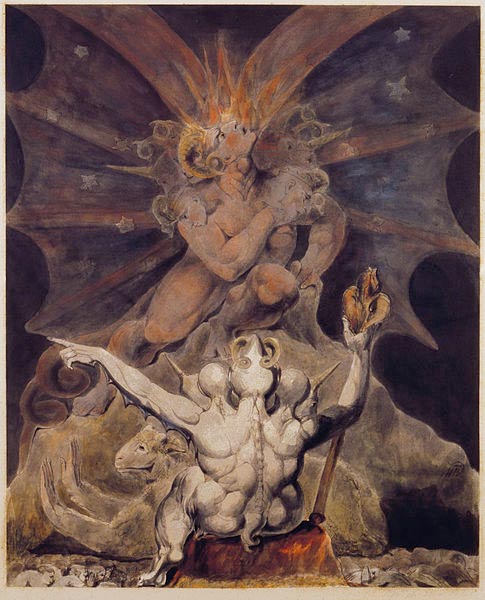
“The Number of the Beast is 666”, by William Blake, 1805. (Public Domain)
To scientists, and those who demand proof, the answer is possibly. The rationalists often point to the statistical probability of recognizable patterns. For instance, take any book, even Moby Dick for instance, and word patterns are bound to turn up if you look hard enough! Taking this one step further, we can argue that even individual numbers mean something different depending on one’s religious beliefs, traditions and even country of origin.
The number sequence 666, for example, is an evil number associated in Christianity with the anti-Christ, the beast of the Book of Revelation. And, according to H.A. Sanders in “The Number of the Beast in Revelation” in the Journal of Biblical Literature (1918), 666 is the number derived from Gematria from the name of Roman Emperor Nero Caesar, who reigned from 54-68 CE and was believed by many scholars to be the beast referenced in Revelation.

A plaster bust of Nero. (CC BY-SA 3.0)
Yet in Chinese tradition, 666 is a beneficial number sequence that means something positive and has no association with evil whatsoever.

Not all number combinations have the same significance between cultures. (Flickr/CC BY-SA 2.0)
But that doesn’t discount the possibility that sacred writings have codes intentionally built in to the text, and with the ancient knowledge and understanding of the power and importance of numbers and words, it isn’t too far a stretch to imagine that no matter who authored them, they might contain more wisdom between the lines than is obvious at first sight. It just takes the time and attention to sort it all out and find the patterns, as the ancient Soferim once did long ago.
Featured image: Deriv; Kaballah Tree of Life (Public Domain), Hand Positions (Public Domain), and the Zohar (Public Domain), with text (Public Domain).
References
Clawson, Calvin C. 1999 MATHEMATICAL MYSTERIES: THE BEAUTY AND MAGIC OF NUMBERS. New York, New York: Perseus Books.
Davis, John J. 1968 BIBLICAL NUMEROLOGY. Grand Rapids, Michigan: Baker Books.
Drosnin, Michael. 1998 THE BIBLE CODE. New York, New York: Touchstone Books.
Hughes, J.P. 2008 SUGGESTIVE GEMATRIA. New York, New York: Holmes.
Jones, Marie D. and Larry Flaxman 2009 “11:11-THE TIME PROMPT PHENOMENON. Franklin Hills, New Jersey: New Page Books.
Lawrence, Shirley Blackwell. 2001 THE SECRET SCIENCE OF NUMEROLOGY – THE HIDDEN MEANING OF NUMBERS AND LETTERS. Franklin Hills, New Jersey: New Page Books.
Rawn, Jonathan D. 2008 DISCOVERING GEMATRIA. Gematria Publishing (out of print).
Gal Einai 2016 Gematria (Hebrew Numerology) Index of Tools and Resources. Inner.org [Online] Available at: www.inner.org/Gematria